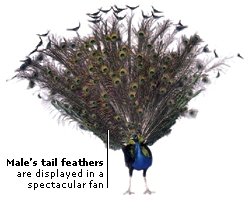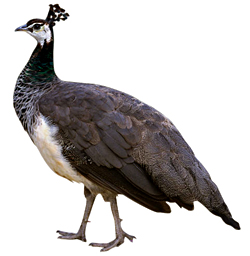Some animals perform complex rituals to attract a mate. These displays, performed during the breeding season, are known as courtship. Usually it is the males that perform. They may court one female or several in turn. Sometimes groups of males perform at a particular spot, called a lek, with females visiting to select a mate. Some animals have only one partner throughout their life. They do not need to perform a display, but they do need to keep a strong bond with their partners.
In some species, males and females look very different. Sometimes the difference is only a matter of size, but during the breeding season other differences may appear. In birds such as peacocks, the males develop elaborate tail feathers, which they fan out and quiver to attract females.
In some birds, the males and females both perform a series of courtship rituals. Great blue herons raise their necks and feathers and dual with each other, shaking twigs and calling out to one another. The feathers of both sexes change to a similar colour during the breeding season, though the males’ are usually more brightly coloured.
Golden lion tamarins mate for life so they do not need to waste energy on courtship displays. They do, however, spend time bonding with their partners by grooming (cleaning) one another. These tamarins live in family groups of about four to eight members. The males help bring up the young, and older siblings also help out so they can learn about parenting.
Male frogs and toads call out to attract females to their breeding pond or stream. Each species has its own call, which helps a female to find a mate of the same species in the breeding pool if it is used by several species at once. Many species, such as the Brazilian torrent frog, have expanding vocal pouches which make their calls loud and clear. These frogs also kick their legs out during courtship displays.
Like birds, many male lizards become more brightly coloured during the breeding season, despite the fact they may be more easily seen by predators. However, the male anole lizards are different. They have permanent colourful dewlaps under their throats that remain hidden unless they are being used to attract females.
In autumn, stags (male deer) start to gather harems (groups) of females to mate with. They fiercely defend these harems from rival males. Usually the larger males with the bigger antlers have their pick of the females. Males of the same size battle to decide which of them will remain with the females and which males must retreat.
Male orchid bees attract females by marking a spot, or lek, with their particular scent. The females that are attracted by the smell fly to the lek, and mate with a male. Birds that attract females by singing or displays may also use leks. Some hoofed mammals use leks when they mark their territory with urine and faeces.









0 comments:
Post a Comment